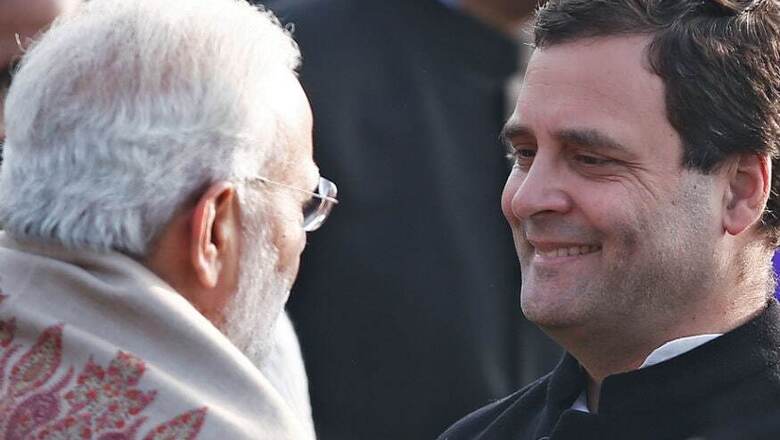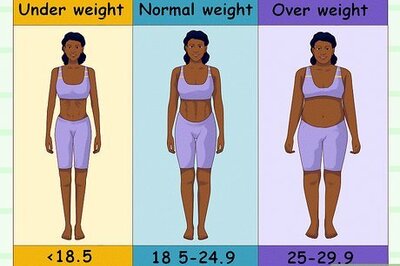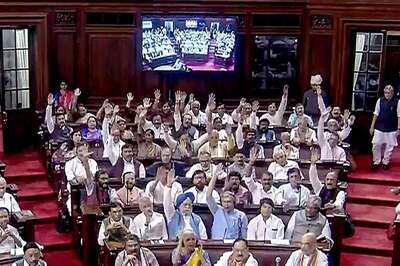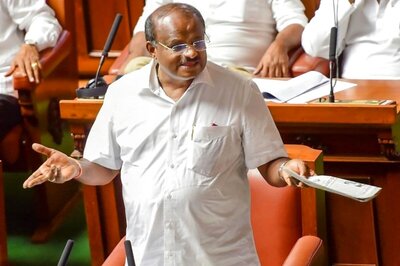
views
New Delhi: With Wayanad candidature, Congress chief Rahul Gandhi has joined the long list of leaders contesting elections from more than one constituency.
While many political observers are of the opinion that Gandhi contesting from Wayanad in Kerala, in addition to his bastion Amethi in Uttar Pradesh, will help the Congress expend its base in south India, the BJP said the move was motivated by fear of losing in Amethi.
More often than not, political leaders have contested from multiple Lok Sabha constituencies, sometimes on as many as three. This was until 1996, when an amendment to the People’s Representation Act, 1951 restricted the number of seats a candidate can simultaneously contest from at two.
While the most recent case of double candidature is that of Prime Minister Narendra Modi, who contested from Vadodara and Varanasi in 2014, one of the most cited instances of multiple candidature is that of Atal Bihari Vajpayee.
The former PM contested from three parliamentary constituencies —Balrampur, Mathura, and Lucknow — in 1957 on a Bharatiya Jana Sangh ticket. The veteran leader won the Balrampur seat; he came second in Lucknow and forfeited his deposit in Mathura.
Vajpayee returned in 1962 and again contested on two seats (Balrampur and Lucknow) and lost both. The three-time PM contested on more than one seat on two more occasions. He fought from Vidisha and Lucknow in 1991, and Gandhinagar and Lucknow in 1996. On both the occasions, he kept the Lucknow seat, which eventually became a BJP stronghold over the years. Later on, he vacated the other two seats which led to by-elections.
Vajpayee’s close friend LK Advani is yet another BJP leader to have contested from two Lok Sabha seats. Advani had contested from New Delhi and Gandhinagar in 1991 parliamentary elections. He was elected from both. Later, he went on to vacate the New Delhi seat.
Even in Congress, Rahul Gandhi is not the first to contest from more than one constituency. His grandmother Indira Gandhi, after she lost her traditional Rae Bareli seat in 1977, contested from Medak (now in Telangana) in addition to the Rae Bareli seat in 1980. She eventually won from both and vacated the Medak seat.
Another southward foray from the Gandhi family was by Sonia Gandhi in 1999 Lok Sabha elections when she fought from Amethi and Bellary in Karnataka. She emerged victorious from both and vacated the Bellary seat.
Apart from BJP and Congress, there have been several instances of strong regional leaders with mass appeal contesting from multiple number of seats.
Samajwadi Party (SP) patron Mulayam Singh Yadav, who contested from Mainpuri and Azamgarh in 2014 had previously fought from two seats in 1999 Lok Sabha election. Yadav had fought from Sambhal and Kannauj in Uttar Pradesh. His son Akhilesh Yadav, too, had contested from Kannauj and Firozabad in 2009. The father-son duo emerged victorious from all these seats.
Even Akhilesh’s former political rival turned alliance partner and Bahujan Samaj Party (BSP) supremo, Mayawati contested on multiple seats early in her political career. In 1989, Mayawati contested from Bijnor and Hardwar seat. She was elected from Bijnor, but lost in Hardwar. Mayawati again tried her luck from three seats — Bijnor, Hardwar, and Bulandshahr — in 1991 elections but lost on all the three seats.
Her mentor and founder of the BSP, Kanshi Ram, contested from more than one seat on three separate occasions and was able to win at least one of them twice. While he lost both Amethi and East Delhi seats that he fought from in 1989, Kanshi Ram was elected from Etawah and lost in East Delhi in 1991. He won from Hoshiarpur in Punjab and lost from Phulpur in 1996 Lok Sabha elections.
Another mass leader, Lalu Prasad Yadav of the Rashtriya Janata Dal (RJD) fielded himself from two seats at least thrice during his political career. His first double attempt came in 1995 Bihar state elections when he was in fray from Raghopur and Dinapur constituency on a Janata Dal (United) ticket. During that election Yadav won both the seats.
After forming his own party, Rashtriya Janata Dal (RJD), Lalu again contested from two Lok Sabha seats during the 2004 elections where he fought from Chapra and Madhepura. In 2009, the RJD supremo fought from Saran and Pataliputra.
The list also includes four-time Odisha Chief Minister Naveen Patnaik. He is another major leader who will be contesting from two seats this election season. The veteran will be contesting from Bijepur and Hinjli Assembly constituencies to seek a fifth term as the CM of the state.
Interestingly, Patnaik’s father Biju Patnaik holds the record of contesting from highest number of seats in a single election. Biju Patnaik had contested from four Assembly seats in Odisha (Chowdwar, Bhubaneswar, Khurda, and Bhanjanagar) and one Lok Sabha constituency in 1971 elections. Considered as one the most popular political figures in Odisha, Patnaik lost on all the five seats he had then fought from.
Among other regional leaders, NT Ramarao (also known as NTR), founder of the Telugu Desam Party (TDP), contested from more than one seat in all the four Assembly elections he fought.
NTR fought from two seats (Gudivada and Tirupati) on his debut in 1983, three seats (Gudivada, Hindupur, and Nalgonda) in 1985, two seats (Kalwakurthi and Hindupur) in 1989, and again two seats (Tekkali and Hindupur) in 1994. Among these, he only lost from the Kalwakurthi constituency in 1989.
AIADMK matriarch J Jayalalithaa also features in the list having contested the 1991 Tamil Nadu state elections from Bargur and Kangayam Assembly constituencies in 1991.
With quite a few frequent instances of dual candidatures, political critics argue that the practice causes bypolls in constituencies that are vacated by these leaders, which in turn is a financial burden on the exchequer.
At present there is a Public Interest Litigation filed in the Supreme Court to amend the People's Representation Act, 1951, to restrict the number of seats a candidate can contest on to only one.
The Election Commission while supporting the plea in an affidavit has said: “When a candidate contests from two seats, it is imperative that he has to vacate one of the two seats if he wins both. This, apart from the consequent unavoidable financial burden on the public exchequer, government manpower and other resources for holding by-election against the resultant vacancy, is also an injustice to the voters of the constituency which the candidate is quitting from."
The apex court is expected to hear the plea later this month.




















Comments
0 comment